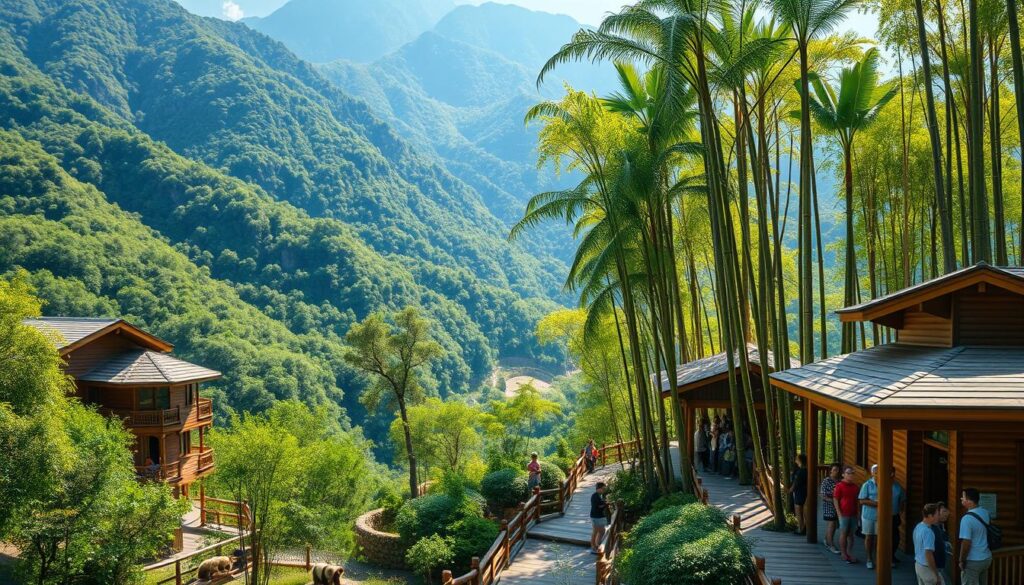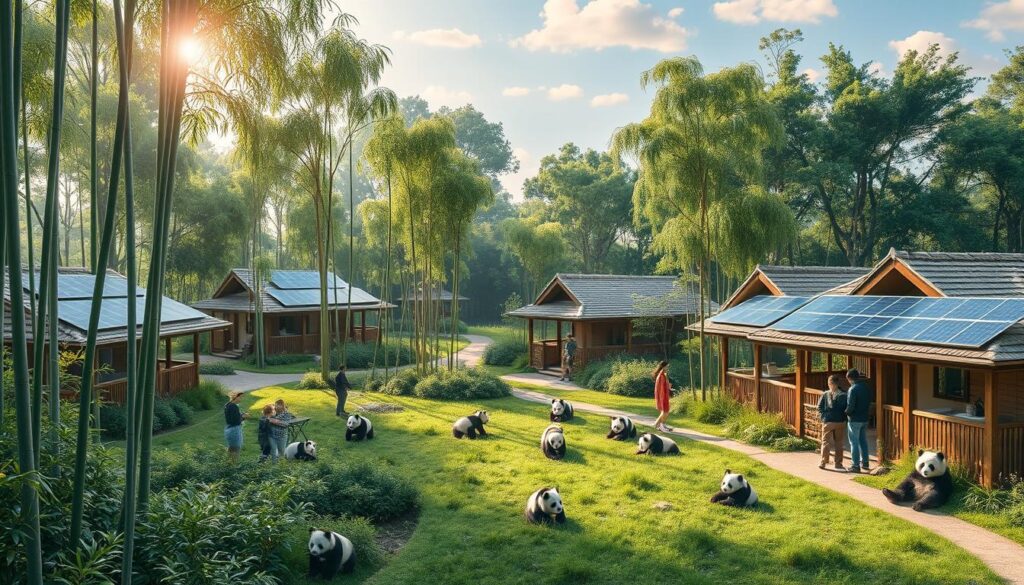The majestic panda is a symbol of wildlife conservation loved by many. Eco-tourism is growing, making it key to use technology for panda conservation. This article explores how tech can help protect panda culture, facing challenges and finding opportunities Cultural Conservation In Eco-Tourism.
Key Takeaways
- Pandas are globally recognized as emblems of wildlife conservation, attracting eco-tourists and raising awareness of environmental protection.
- Eco-tourism in national parks, both internationally and in China, has become a vital tool for sustainable development and cultural preservation.
- Innovative technologies, such as panda webcams and surveillance systems, can enhance cultural conservation efforts by engaging visitors and supporting research.
- Integrating technology into eco-tourism can address challenges like over-tourism and promote responsible travel, benefiting local communities and the environment.
- Successful eco-tourism initiatives often involve collaborative efforts between the public and private sectors, as well as non-governmental organizations.
The Iconic Status of Pandas
Pandas hold a special place in the natural world. They are symbols of wildlife conservation and have captured the hearts of people worldwide. Their black-and-white fur, gentle nature, and unique diet make them both vulnerable and loved.
Pandas as Emblems of Wildlife Conservation
Pandas are seen as symbols of the need to save endangered species and their homes. With only about 1,860 pandas left in the wild, their survival is a big focus for conservation. Their status has helped bring attention and money to many conservation projects.
Charismatic Species Attracting Global Attention
The panda’s looks and behavior have made it famous. It’s often seen in documentaries, webcams, and zoos. This fame has inspired people to care about nature and support conservation. Pandas also help in “panda diplomacy,” where they are given as gifts to build friendships between countries.
| Panda Conservation Statistics | Value |
|---|---|
| Bamboo Consumption per Day | Up to 40 pounds |
| Time Spent Eating per Day | 10-16 hours |
| Average Lifespan in the Wild | 20 years |
| Panda Reserves Established | Over 60 |
| IUCN Panda Conservation Status | Vulnerable |
The panda’s fame and charm have made it a key species in how we see nature and conservation. By saving pandas, we protect not just them but also many other species and ecosystems.
Overview of Eco-Tourism in National Parks

Eco-tourism is key in managing national parks around the world. It lets visitors enjoy nature while helping protect it. This article looks at eco-tourism in national parks globally, showing different ways to support sustainable tourism.
Current Status and Trends in Foreign National Parks
In the United States, eco-tourism is big, with both private and public efforts. Costa Rica is famous for its eco-tourism, thanks to strict laws to keep nature safe. Australia was the first to have a detailed eco-tourism plan, with a program for eco-friendly tours.
Development of Eco-Tourism in Chinese National Parks
China is also growing its eco-tourism in national parks. It aims to protect the environment while growing tourism. This has brought more visitors, helping to keep China’s natural and cultural treasures safe.
| Country | Eco-Tourism Trends | Key Initiatives |
|---|---|---|
| United States | Eco-tourism is a pillar industry with private and regional self-management models, as well as government support. | Promotion of eco-tourism activities and development of eco-friendly infrastructure. |
| Costa Rica | World-renowned eco-tourism destination with strict legislation and enforcement to protect natural environments. | Sustainable tourism policies and eco-certification programs. |
| Australia | First country to implement a comprehensive eco-tourism strategy with a well-developed eco-certification program. | Eco-certification program for tour operators and promotion of eco-friendly activities. |
| China | Significant growth in eco-tourism within national parks, balancing environmental protection and sustainable tourism. | Eco-certification schemes and promotion of eco-friendly activities in national parks. |
Eco-tourism in national parks worldwide shows how important it is for preserving nature and culture. As it grows, national parks must find the right balance between protecting the environment and welcoming visitors responsibly.
Role of Technology in Cultural Conservation

Technology has become a key player in helping protect our cultural heritage. Tools like webcams and “panda cams” have changed how we watch endangered animals like pandas. These systems let people worldwide see these animals in their homes, creating a closer bond between humans and animals.
Thanks to these technologies, more people learn about and care for endangered species. For example, panda cams let us see pandas’ daily lives. This makes us appreciate these animals and their homes more. It also encourages us to help protect them and choose eco-friendly travel.
Technology also helps make eco-tourism greener. Using digital tools cuts down on paper and helps us travel more sustainably. Hotels are now using green energy and smart waste systems. This makes tourism better for our planet.
| Technology Impact | Percentage Reduction |
|---|---|
| Carbon footprint reduction through digitization | 15-20% |
| Renewable energy integration in the hotel industry | 25-30% |
| Waste management system efficiency improvements | 12-18% |
Technology is a powerful tool for eco-tourism. It helps protect our cultural heritage, teaches us about the environment, and promotes green travel. It also strengthens our connection with nature.
Panda Cams: Animal Surveillance and Webcams

Panda cams let us watch pandas in zoos or nature reserves. They make these critical endangered species seem closer to us. It feels like we can see their lives anytime.
Ethics and Implications of Panda Webcam Technology
Panda cams give us a peek into the pandas’ world. But, they also make us think about how we treat nature. They show pandas in managed environments, which might not be good for them.
These webcams can make us feel like we’re just watching, not really experiencing. This can lessen our respect for the animals and their homes. It’s important to think about how these cameras affect our understanding of nature and our connection to it.
“Panda cams can create the illusion of unfettered access to the lives of these animals, but in reality, they often represent a disconnect from the true nature and autonomy of the pandas themselves.”
Cultural Conservation in Eco-Tourism

Eco-tourism can greatly help in saving cultural heritage and promoting green tourism. It lets communities share their natural and cultural treasures. This way, people learn to value local traditions and identities more.
In 2012, eco-tourism made up about 25% of global tourism income, says the United Nations Environment Programme. This shows a chance to show off the cultural wealth of places. Visitors can then enjoy real cultural experiences.
Green tourism aims to balance its effects on the economy, society, and environment. The Global Sustainable Tourism Council (GSTC) sets standards for this. These standards cover management, social, cultural, and environmental impacts.
By following these guidelines, eco-tourism can help communities keep their heritage alive. It lets them share their culture and care for the environment. This enriches the visitor’s experience and helps the place thrive in the long run.
But, adding cultural care to eco-tourism comes with its own hurdles. Issues like economic harm and environmental damage need to be fixed. Using responsible travel and GSTC Criteria can help solve these problems.
The need for eco-tourism to focus on cultural preservation is growing. By choosing sustainable tourism, we can protect our world’s diversity. This benefits both travelers and the local communities.
Challenges and Opportunities for Technology Integration
The use of technology in eco-tourism has its ups and downs. One big issue is that it might make over-tourism worse. This is because more people can see and visit natural places, which can harm them.
But, technology can also help solve over-tourism and encourage responsible travel. Online tools help people find eco-friendly places to stay and learn about sustainable tourism. There are also apps that rate places based on how green they are.
Apps for getting around suggest better ways to travel, like using less gas. They also track how much carbon you use. QR codes share cool facts about green practices at places you visit. And, there are apps that teach you about animals and how to see them safely.
Addressing Over-Tourism and Responsible Travel
Technology also helps support local communities through community-based tourism. It helps local businesses and makes sure people are treated fairly. Apps can make learning about being green fun by using games.
Soon, we’ll see even more cool tech for traveling green. This includes AI and blockchain for better travel tips and checking if places are really eco-friendly. Social media stars can also help by sharing their green adventures.
There are also online classes and workshops to teach people about being green while traveling. This helps protect our planet and its cultures.
| Technology Integration | Eco-Tourism Benefits |
|---|---|
| Online research platforms | Provide eco-friendly travel information |
| Eco-ratings for accommodations | Incorporate sustainability data |
| Transportation apps | Suggest eco-friendly modes, track emissions |
| Multimedia content via QR codes | Educate about sustainable practices |
| AR guides | Promote responsible wildlife interactions |
By using technology wisely, eco-tourism can help protect our planet. It can also make sure we don’t overdo it when visiting natural places. This way, we can enjoy nature while keeping it safe for the future.
Initiatives and Best Practices

To protect cultural heritage in eco-tourism, many efforts have been made worldwide. These steps aim to keep both nature and culture safe while supporting tourism. This way, we can enjoy travel while also caring for our planet and its history.
Eco-Certification and Standards
Top eco-tourism spots have set up strict rules and certifications. For example, Costa Rica has the Certificate for Sustainable Tourism (CST). Iceland and Kenya also have their own eco-standards. These programs help travelers find places that care for the environment and culture.
Community-Based Initiatives
Working with local people is key for eco-tourism success. In Bhutan, a special fee helps fund cultural and green projects. In the Galápagos Islands, local groups protect the area and teach visitors to travel right.
Visitor Education and Awareness
Teaching visitors about conservation is vital. Places like Kenya and Tanzania have rules to keep tourism green. Signs, tours, and classes help travelers understand and respect local places.
| Destination | Eco-Tourism Initiatives | Key Outcomes |
|---|---|---|
| Costa Rica | Forever Costa Rica’s Protected Areas Program | Raised over $5 million since 2010 for conservation efforts |
| Iceland | Reliance on renewable energy sources | Approximately 85% of primary energy from renewables, 66% from geothermal |
| Bhutan | Sustainable Development Fee | Funds cultural and environmental development projects |
These examples show how different places are working to protect culture and nature. They show us the many ways to make tourism better for our planet and its stories.
Also Read : What Are The Limitations Of Current Panda Monitoring Technologies?
Conclusion
Technology is changing the eco-tourism world, especially for panda conservation. It makes it easier for people to see pandas, which helps us connect with nature. This also teaches us about the environment.
Eco-tourism is growing, and it’s focusing on being green and responsible. This helps protect nature, culture, and communities. But, we need to solve problems like too many tourists and fake green claims to keep it positive.
The future looks bright for eco-tourism and technology together. They can help us see more of nature and protect it. This way, we can learn to appreciate our world and its connection to us better.
FAQs
Q: How does technology play a role in cultural heritage conservation within eco-tourism for pandas?
A: Technology enhances cultural heritage conservation by providing innovative tools for monitoring biodiversity and assessing the impact of tourism activities. It aids in data collection and analysis, helping stakeholders implement effective conservation initiatives.
Q: What are some examples of sustainable tourism practices that can improve conservation of the natural and cultural heritage related to pandas?
A: Sustainable tourism practices include responsible wildlife viewing, educational programs about panda habitats, and community involvement in conservation efforts. These practices help preserve cultural values while providing economic benefits to local communities.
Q: How can eco-tourism contribute to the conservation of the natural resources in panda habitats?
A: Eco-tourism can contribute by promoting sustainable tourism development that minimizes ecological footprints and encourages the protection of natural resources. It also helps raise awareness among tourists about the importance of conserving panda habitats and biodiversity.
Q: In what ways can technology enhance the visitor experience in eco-tourism focused on pandas?
A: Technology can enhance visitor experiences through interactive apps, virtual reality tours, and informative kiosks that provide insights into panda behavior and habitat. This engagement helps tourists appreciate the cultural identity and conservation efforts related to pandas.
Q: What is the role of ecotourism in promoting cultural identity and heritage conservation for pandas?
A: Ecotourism plays a crucial role by fostering a connection between tourists and the local culture, highlighting the significance of pandas in the region’s cultural heritage. This connection encourages respect for cultural values and supports conservation efforts.
Q: How can stakeholders utilize technology for effective conservation initiatives in panda eco-tourism?
A: Stakeholders can use technology for data-driven decision-making, tracking wildlife populations, and monitoring the impact of tourism. Tools like GIS and remote sensing can provide qualitative insights into the social-ecological system surrounding panda habitats.
Q: What are the economic benefits of integrating technology into eco-tourism for pandas?
A: Integrating technology can lead to increased visitor satisfaction and retention, boosting the tourism industry. It can also attract a broader audience interested in wildlife conservation, resulting in higher revenue for local communities engaged in sustainable practices.
Q: How does the study area influence the application of technology in eco-tourism for panda conservation?
A: The study area influences the application of technology by determining the specific ecological and cultural contexts that need to be addressed. Tailoring technology solutions to local conditions ensures that conservation efforts are effective and culturally relevant.
Q: What challenges might arise when using technology for cultural heritage conservation in panda eco-tourism?
A: Challenges include ensuring access to technology in remote areas, balancing technological implementation with traditional practices, and addressing potential negative impacts of tourism on the ecological balance and cultural integrity.
Source Links
- https://www.e3sconferences.org/articles/e3sconf/pdf/2020/03/e3sconf_arfee2020_02036.pdf
- https://academicarchive.snhu.edu/bitstream/handle/10474/1802/sced2010calderon.pdf
- https://www.vaia.com/en-us/explanations/chinese/chinese-social-issues/eco-tourism-in-china/
- https://wilderness-society.org/the-endearing-giant-panda-a-symbol-of-conservation/
- https://www.wwf.org.uk/learn/wildlife/giant-pandas

